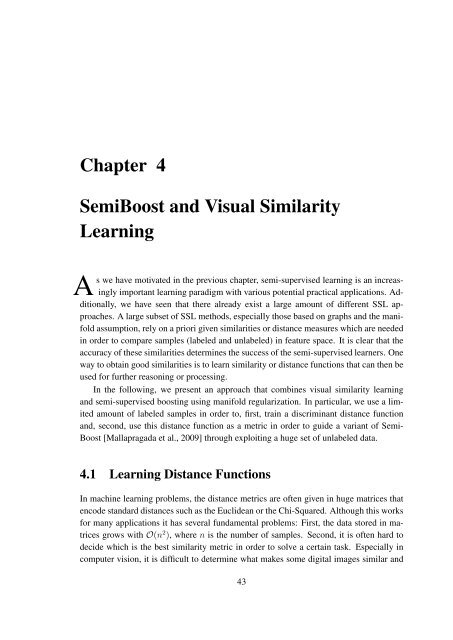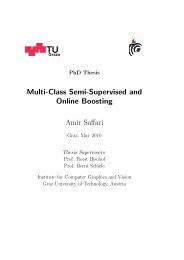PhD Thesis Semi-Supervised Ensemble Methods for Computer Vision
PhD Thesis Semi-Supervised Ensemble Methods for Computer Vision
PhD Thesis Semi-Supervised Ensemble Methods for Computer Vision
Create successful ePaper yourself
Turn your PDF publications into a flip-book with our unique Google optimized e-Paper software.
Chapter 4<br />
<strong>Semi</strong>Boost and Visual Similarity<br />
Learning<br />
As we have motivated in the previous chapter, semi-supervised learning is an increasingly<br />
important learning paradigm with various potential practical applications. Additionally,<br />
we have seen that there already exist a large amount of different SSL approaches.<br />
A large subset of SSL methods, especially those based on graphs and the manifold<br />
assumption, rely on a priori given similarities or distance measures which are needed<br />
in order to compare samples (labeled and unlabeled) in feature space. It is clear that the<br />
accuracy of these similarities determines the success of the semi-supervised learners. One<br />
way to obtain good similarities is to learn similarity or distance functions that can then be<br />
used <strong>for</strong> further reasoning or processing.<br />
In the following, we present an approach that combines visual similarity learning<br />
and semi-supervised boosting using manifold regularization. In particular, we use a limited<br />
amount of labeled samples in order to, first, train a discriminant distance function<br />
and, second, use this distance function as a metric in order to guide a variant of <strong>Semi</strong>-<br />
Boost [Mallapragada et al., 2009] through exploiting a huge set of unlabeled data.<br />
4.1 Learning Distance Functions<br />
In machine learning problems, the distance metrics are often given in huge matrices that<br />
encode standard distances such as the Euclidean or the Chi-Squared. Although this works<br />
<strong>for</strong> many applications it has several fundamental problems: First, the data stored in matrices<br />
grows with O(n 2 ), where n is the number of samples. Second, it is often hard to<br />
decide which is the best similarity metric in order to solve a certain task. Especially in<br />
computer vision, it is difficult to determine what makes some digital images similar and<br />
43



